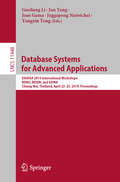 Database Systems for Advanced Applications: DASFAA 2019 International Workshops: BDMS, BDQM, and GDMA, Chiang Mai, Thailand, April 22–25, 2019, Proceedings (Lecture Notes in Computer Science #11448)
5919988
Database Systems for Advanced Applications: DASFAA 2019 International Workshops: BDMS, BDQM, and GDMA, Chiang Mai, Thailand, April 22–25, 2019, Proceedings (Lecture Notes in Computer Science #11448)
5919988
|
Jun Yang
Yongxin Tong
Guoliang Li
Joao Gama
Juggapong Natwichai
|
9783030185909 |
2019 |
Contains images
|
|
 Database Systems: A Practical Approach to Design, Implementation, and Management (6th Edition)
1803873
Database Systems: A Practical Approach to Design, Implementation, and Management (6th Edition)
1803873
|
Thomas Connolly
Carolyn Begg
|
9780132943260 |
2015 |
|
|
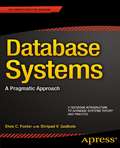 Database Systems: A Pragmatic Approach
2102260
Database Systems: A Pragmatic Approach
2102260
|
Elvis C. Foster
Shripad V. Godbole
|
9781484208779 |
2010 |
Contains images
|
|
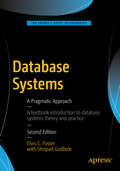 Database Systems: A Pragmatic Approach
2102281
Database Systems: A Pragmatic Approach
2102281
|
Elvis C. Foster
Shripad Godbole
|
9781484211915 |
2014 |
Contains images
|
|
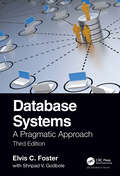 Database Systems: A Pragmatic Approach, 3rd edition
4893186
Database Systems: A Pragmatic Approach, 3rd edition
4893186
|
Elvis C. Foster
Shripad V. Godbole
|
9781000562125 |
2022 |
Contains images
|
|
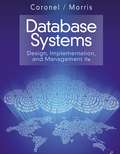 Database Systems: Design, Implementation, and Management (Eleventh Edition)
1084816
Database Systems: Design, Implementation, and Management (Eleventh Edition)
1084816
|
Steven Morris
Carlos Coronel
|
9781285196145 |
2015 |
|
|
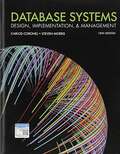 Database Systems: Design, Implementation, and Management (Mindtap Course List Series)
5524858
Database Systems: Design, Implementation, and Management (Mindtap Course List Series)
5524858
|
Steven Morris
Carlos Coronel
|
9780357687536 |
2023 |
Contains images
|
|
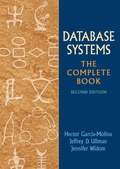 Database Systems: The Complete Book
3401715
Database Systems: The Complete Book
3401715
|
Jeffrey D. Ullman
Hector Garcia-Molina
Jennifer Widom
|
9780131873254 |
2009 |
|
|
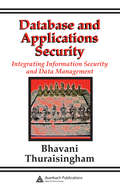 Database and Applications Security: Integrating Information Security and Data Management
3353014
Database and Applications Security: Integrating Information Security and Data Management
3353014
|
Bhavani Thuraisingham
|
9781135489106 |
2005 |
Contains images
|
|
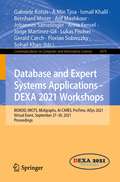 Database and Expert Systems Applications - DEXA 2021 Workshops: BIOKDD, IWCFS, MLKgraphs, AI-CARES, ProTime, AISys 2021, Virtual Event, September 27–30, 2021, Proceedings (Communications in Computer and Information Science #1479)
4510876
Database and Expert Systems Applications - DEXA 2021 Workshops: BIOKDD, IWCFS, MLKgraphs, AI-CARES, ProTime, AISys 2021, Virtual Event, September 27–30, 2021, Proceedings (Communications in Computer and Information Science #1479)
4510876
|
Ismail Khalil
A Min Tjoa
Atif Mashkoor
Anna Fensel
Johannes Sametinger
Bernhard Moser
Jorge Martinez-Gil
Gabriele Kotsis
Lukas Fischer
Sohail Khan
Gerald Czech
Florian Sobieczky
|
9783030871017 |
2021 |
Contains images
|
|
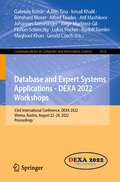 Database and Expert Systems Applications - DEXA 2022 Workshops: 33rd International Conference, DEXA 2022, Vienna, Austria, August 22–24, 2022, Proceedings (Communications in Computer and Information Science #1633)
5927854
Database and Expert Systems Applications - DEXA 2022 Workshops: 33rd International Conference, DEXA 2022, Vienna, Austria, August 22–24, 2022, Proceedings (Communications in Computer and Information Science #1633)
5927854
|
Ismail Khalil
A Min Tjoa
Atif Mashkoor
Johannes Sametinger
Bernhard Moser
Jorge Martinez-Gil
Gabriele Kotsis
Lukas Fischer
Gerald Czech
Florian Sobieczky
Alfred Taudes
Rudolf Ramler
Maqbool Khan
|
9783031143434 |
2022 |
Contains images
|
|
 Database and Expert Systems Applications - DEXA 2023 Workshops: 34th International Conference, DEXA 2023, Penang, Malaysia, August 28–30, 2023, Proceedings (Communications in Computer and Information Science #1872)
5927940
Database and Expert Systems Applications - DEXA 2023 Workshops: 34th International Conference, DEXA 2023, Penang, Malaysia, August 28–30, 2023, Proceedings (Communications in Computer and Information Science #1872)
5927940
|
Ismail Khalil
A Min Tjoa
Atif Mashkoor
Johannes Sametinger
Bernhard Moser
Gabriele Kotsis
Maqbool Khan
|
9783031396892 |
2023 |
Contains images
|
|
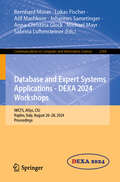 Database and Expert Systems Applications - DEXA 2024 Workshops: IWCFS, AISys, CIU, Naples, Italy, August 26–28, 2024, Proceedings (Communications in Computer and Information Science #2169)
6152264
Database and Expert Systems Applications - DEXA 2024 Workshops: IWCFS, AISys, CIU, Naples, Italy, August 26–28, 2024, Proceedings (Communications in Computer and Information Science #2169)
6152264
|
Atif Mashkoor
Johannes Sametinger
Bernhard Moser
Lukas Fischer
Anna-Christina Glock
Michael Mayr
Sabrina Luftensteiner
|
9783031683022 |
2024 |
Contains images
|
|
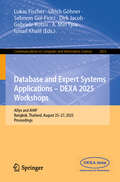 Database and Expert Systems Applications - DEXA 2025 Workshops: AISys and AI4IP, Bangkok, Thailand, August 25–27, 2025, Proceedings (Communications in Computer and Information Science #2615)
6726405
Database and Expert Systems Applications - DEXA 2025 Workshops: AISys and AI4IP, Bangkok, Thailand, August 25–27, 2025, Proceedings (Communications in Computer and Information Science #2615)
6726405
|
Ismail Khalil
A Min Tjoa
Gabriele Kotsis
Lukas Fischer
Ulrich Göhner
Sebnem Gül-Ficici
Dirk Jacob
|
9783032020031 |
2026 |
Contains images
|
|
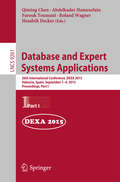 Database and Expert Systems Applications: 26th International Conference, DEXA 2015, Valencia, Spain, September 1-4, 2015, Proceedings, Part I (Lecture Notes in Computer Science #9261)
2107855
Database and Expert Systems Applications: 26th International Conference, DEXA 2015, Valencia, Spain, September 1-4, 2015, Proceedings, Part I (Lecture Notes in Computer Science #9261)
2107855
|
Abdelkader Hameurlain
Roland Wagner
Hendrik Decker
Farouk Toumani
Qiming Chen
|
9783319228495 |
2015 |
Contains images
|
|
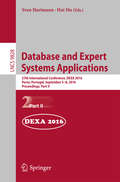 Database and Expert Systems Applications: 27th International Conference, DEXA 2016, Porto, Portugal, September 5-8, 2016, Proceedings, Part II (Lecture Notes in Computer Science #9828)
2110930
Database and Expert Systems Applications: 27th International Conference, DEXA 2016, Porto, Portugal, September 5-8, 2016, Proceedings, Part II (Lecture Notes in Computer Science #9828)
2110930
|
Sven Hartmann
Hui Ma
|
9783319444062 |
2016 |
Contains images
|
|
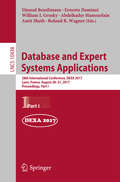 Database and Expert Systems Applications: 28th International Conference, DEXA 2017, Lyon, France, August 28-31, 2017, Proceedings, Part I (Lecture Notes in Computer Science #10438)
5928443
Database and Expert Systems Applications: 28th International Conference, DEXA 2017, Lyon, France, August 28-31, 2017, Proceedings, Part I (Lecture Notes in Computer Science #10438)
5928443
|
Djamal Benslimane, Ernesto Damiani, William I. Grosky, Abdelkader Hameurlain, Amit Sheth and Roland R. Wagner
|
9783319644684 |
2017 |
Contains images
|
|
 Database and Expert Systems Applications: 28th International Conference, DEXA 2017, Lyon, France, August 28-31, 2017, Proceedings, Part II (Lecture Notes in Computer Science #10439)
5927391
Database and Expert Systems Applications: 28th International Conference, DEXA 2017, Lyon, France, August 28-31, 2017, Proceedings, Part II (Lecture Notes in Computer Science #10439)
5927391
|
Djamal Benslimane, Ernesto Damiani, William I. Grosky, Abdelkader Hameurlain, Amit Sheth and Roland R. Wagner
|
9783319644714 |
2017 |
Contains images
|
|
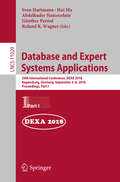 Database and Expert Systems Applications: 29th International Conference, DEXA 2018, Regensburg, Germany, September 3–6, 2018, Proceedings, Part I (Lecture Notes in Computer Science #11029)
5926337
Database and Expert Systems Applications: 29th International Conference, DEXA 2018, Regensburg, Germany, September 3–6, 2018, Proceedings, Part I (Lecture Notes in Computer Science #11029)
5926337
|
Abdelkader Hameurlain
Sven Hartmann
Hui Ma
Günther Pernul
Roland R. Wagner
|
9783319988092 |
2018 |
Contains images
|
|
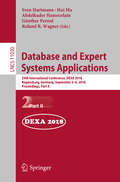 Database and Expert Systems Applications: 29th International Conference, DEXA 2018, Regensburg, Germany, September 3–6, 2018, Proceedings, Part II (Lecture Notes in Computer Science #11030)
5925110
Database and Expert Systems Applications: 29th International Conference, DEXA 2018, Regensburg, Germany, September 3–6, 2018, Proceedings, Part II (Lecture Notes in Computer Science #11030)
5925110
|
Abdelkader Hameurlain
Sven Hartmann
Hui Ma
Günther Pernul
Roland R. Wagner
|
9783319988122 |
2018 |
Contains images
|
|
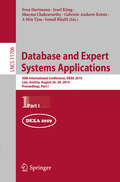 Database and Expert Systems Applications: 30th International Conference, DEXA 2019, Linz, Austria, August 26–29, 2019, Proceedings, Part I (Lecture Notes in Computer Science #11706)
5925881
Database and Expert Systems Applications: 30th International Conference, DEXA 2019, Linz, Austria, August 26–29, 2019, Proceedings, Part I (Lecture Notes in Computer Science #11706)
5925881
|
Josef Küng
Ismail Khalil
A Min Tjoa
Sven Hartmann
Sharma Chakravarthy
Gabriele Anderst-Kotsis
|
9783030276157 |
2019 |
Contains images
|
|
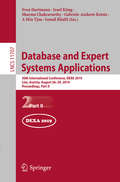 Database and Expert Systems Applications: 30th International Conference, DEXA 2019, Linz, Austria, August 26–29, 2019, Proceedings, Part II (Lecture Notes in Computer Science #11707)
5928641
Database and Expert Systems Applications: 30th International Conference, DEXA 2019, Linz, Austria, August 26–29, 2019, Proceedings, Part II (Lecture Notes in Computer Science #11707)
5928641
|
Josef Küng
Ismail Khalil
A Min Tjoa
Sven Hartmann
Sharma Chakravarthy
Gabriele Anderst-Kotsis
|
9783030276188 |
2019 |
Contains images
|
|
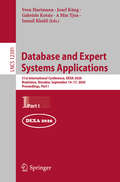 Database and Expert Systems Applications: 31st International Conference, DEXA 2020, Bratislava, Slovakia, September 14–17, 2020, Proceedings, Part I (Lecture Notes in Computer Science #12391)
5928931
Database and Expert Systems Applications: 31st International Conference, DEXA 2020, Bratislava, Slovakia, September 14–17, 2020, Proceedings, Part I (Lecture Notes in Computer Science #12391)
5928931
|
Josef Küng
Ismail Khalil
A Min Tjoa
Sven Hartmann
Gabriele Kotsis
|
9783030590031 |
2020 |
Contains images
|
|
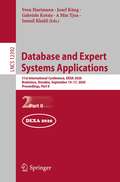 Database and Expert Systems Applications: 31st International Conference, DEXA 2020, Bratislava, Slovakia, September 14–17, 2020, Proceedings, Part II (Lecture Notes in Computer Science #12392)
5919820
Database and Expert Systems Applications: 31st International Conference, DEXA 2020, Bratislava, Slovakia, September 14–17, 2020, Proceedings, Part II (Lecture Notes in Computer Science #12392)
5919820
|
Josef Küng
Ismail Khalil
A Min Tjoa
Sven Hartmann
Gabriele Kotsis
|
9783030590512 |
2020 |
Contains images
|
|
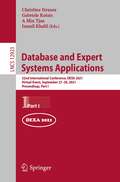 Database and Expert Systems Applications: 32nd International Conference, DEXA 2021, Virtual Event, September 27–30, 2021, Proceedings, Part I (Lecture Notes in Computer Science #12923)
5928475
Database and Expert Systems Applications: 32nd International Conference, DEXA 2021, Virtual Event, September 27–30, 2021, Proceedings, Part I (Lecture Notes in Computer Science #12923)
5928475
|
Ismail Khalil
A Min Tjoa
Christine Strauss
Gabriele Kotsis
|
9783030864729 |
2021 |
Contains images
|
|